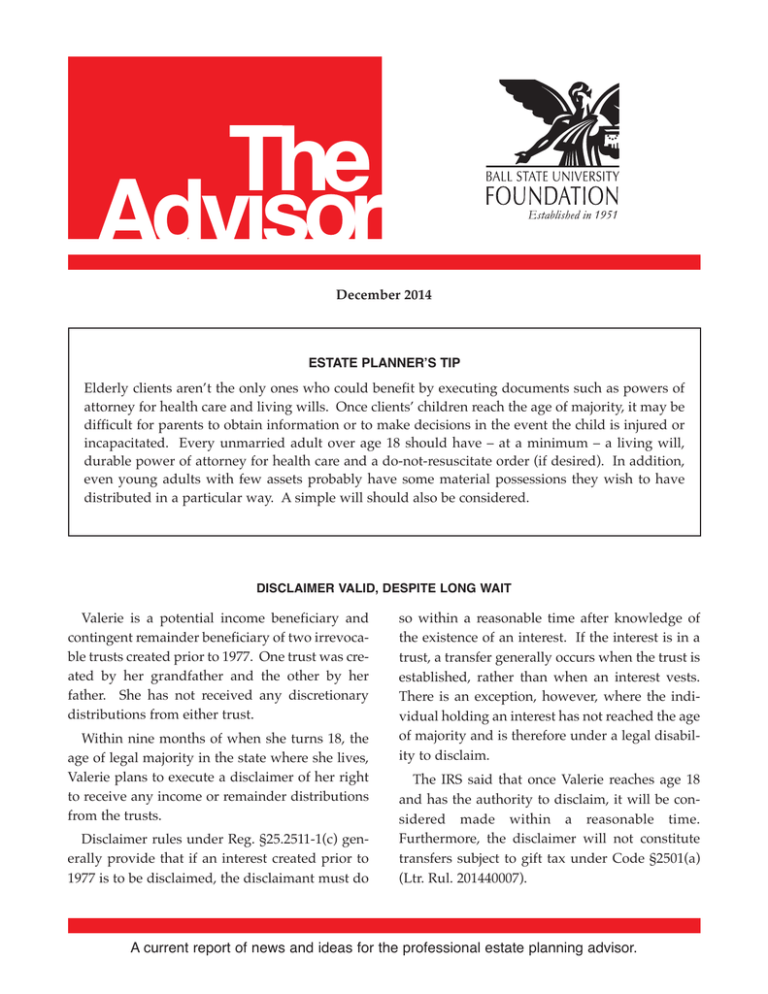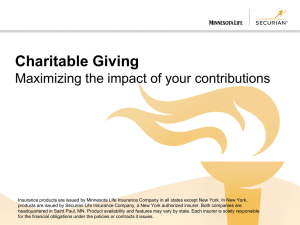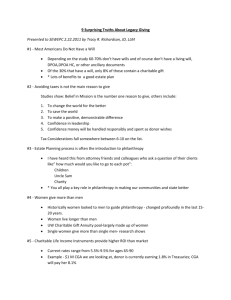The Advisor |
advertisement

The| Advisor December 2014 ESTATE PLANNER’S TIP Elderly clients aren’t the only ones who could benefit by executing documents such as powers of attorney for health care and living wills. Once clients’ children reach the age of majority, it may be difficult for parents to obtain information or to make decisions in the event the child is injured or incapacitated. Every unmarried adult over age 18 should have – at a minimum – a living will, durable power of attorney for health care and a do-not-resuscitate order (if desired). In addition, even young adults with few assets probably have some material possessions they wish to have distributed in a particular way. A simple will should also be considered. DISCLAIMER VALID, DESPITE LONG WAIT Valerie is a potential income beneficiary and contingent remainder beneficiary of two irrevocable trusts created prior to 1977. One trust was created by her grandfather and the other by her father. She has not received any discretionary distributions from either trust. Within nine months of when she turns 18, the age of legal majority in the state where she lives, Valerie plans to execute a disclaimer of her right to receive any income or remainder distributions from the trusts. Disclaimer rules under Reg. §25.2511-1(c) generally provide that if an interest created prior to 1977 is to be disclaimed, the disclaimant must do so within a reasonable time after knowledge of the existence of an interest. If the interest is in a trust, a transfer generally occurs when the trust is established, rather than when an interest vests. There is an exception, however, where the individual holding an interest has not reached the age of majority and is therefore under a legal disability to disclaim. The IRS said that once Valerie reaches age 18 and has the authority to disclaim, it will be considered made within a reasonable time. Furthermore, the disclaimer will not constitute transfers subject to gift tax under Code §2501(a) (Ltr. Rul. 201440007). A current report of news and ideas for the professional estate planning advisor. The Advisor THE UPS AND DOWNS OF SOCIAL SECURITY The earnings limit for 2015 will increase to $118,500, compared to $117,000 in 2014, for Social Security withholding. The rate remains at 7.65% for both the employee and employer (15.3% for self-employed). There is no earnings limit on the Medicare portion of Social Security withholding, which is 1.45% on all earnings. Individuals with earned income of more than $200,000 ($250,000 for married couples) are subject to an additional .9% in Medicare taxes. Social Security recipients ages 62 to 65 will be able to earn up to $15,720 – versus $15,480 in 2014 – before benefits are subject to cutbacks. Benefits are reduced by $1 for every $2 in earnings above the limit. There is no earnings limit for those who reach full retirement age. The maximum Social Security benefit for workers at full retirement age increases from $2,642 in 2014 to $2,663 in 2015, representing a 1.7% cost-of-living adjustment. OPPORTUNITY TO SAVE MORE IN 2015 Employees participating in 401(k) plans will be able to contribute an additional $500 beginning in 2015. A cost-of-living adjustment increases the contribution limit to $18,000, compared to $17,500 in 2014. The catch-up contribution for PHILANTHROPY PUZZLER Several years ago Jeff made two gifts to his favorite charity. The first was a 50% undivided interest in a vacation cottage about an hour from his home [Reg. §1.170A-7(b)(1)(i)]. The second was a remainder interest (not in a trust) in his farm [Code §170(f)(3)(B)(i)]. Both gifts qualified for a charitable deduction. Jeff would like to retire from farming and move to another state. He will no longer use the cottage and doesn’t have family members who wish to farm the land or use the cottage. What are Jeff’s options? workers ages 50 and older also increases, from $5,500 to $6,000. There is no change to the $5,500 maximum IRA contribution. The $1,000 IRA catch-up contribution for those ages 50 and older is not subject to inflation adjustments. IRS: SALE TO DISQUALIFIED PERSON NOT SELF-DEALING Maria was a substantial contributor to a charitable trust classified as a private foundation, making her a disqualified person under Code §4946(a). She owned two contiguous parcels of real estate adjacent to land owned by her son, George, also a disqualified person. In her will, Maria gave a life estate in one of the two parcels to George, so long as he uses the land as a primary residence. The foundation was given the remainder interest in the parcel. Maria left the second parcel to the foundation in fee simple. The foundation indicated that it would prefer cash rather than the remainder and fee simple interests, in order to provide funds for its charitable operations. However, given the condition of the property, its location and George’s life estate, the market for the remainder interest is extremely limited, as is the market for the land given to the foundation. The most likely potential buyer is George, who has expressed an interest in purchasing the interests from the estate. State law permits an executor to take possession and control of real property if in the best interest of administering the estate and if approved by the probate court. Maria’s will gives the executor the power to sell real property. The foundation, George and the executor have determined that selling the property is in the best interest of administering the estate. The parties plan to obtain an independent appraisal of the remainder and fee simple interests. Maria’s estate has not yet been terminated for income tax purposes and will remain open through the proposed sale and distribution of assets to the foundation. Under Code §4941(d)(1)(A), any direct or indirect sale or exchange of property between a private foundation and a disqualified person is self- The Advisor dealing. There is an exception for transactions involving a foundation’s interest or expectancy in property held by an estate if the executor has the power to sell property, the transaction is approved by the probate court and occurs before the estate is terminated, if the foundation receives an amount equal to or exceeding fair market value and the foundation receives an interest at least as liquid as what it gives up. The IRS ruled that the cash sale by the estate to George for fair market value falls within the exception of Reg. §53.4941(d)-1(b)(3) and will not be self-dealing (Ltr. Rul. 201441020). TAX COURT PUSHES BACK WHEN DONOR GETS GREEDY On his 2009 income tax return, Thad Smith claimed itemized deductions of $52,810, including $490 in charitable gifts. When the IRS began reviewing his deductions, Smith filed an amended return on which he increased his charitable deduction for noncash gifts to $27,767. All the gifts involved contributions to AMVETS and fell into three categories: household furnishings with a value of $11,730, clothing valued at $14,487 and electronic equipment valued at $1,550. Smith presented the Tax Court with a spreadsheet showing the items he had given, indicating that he obtained values from a website operated by The Salvation Army Family Stores. The court noted that Smith relied on 2014 values, although his gifts were made in 2009. In addition, the values he used were considerably higher than the “high” values listed on the website. The court pointed out that substantiation requirements fall into three general categories: (1) gifts of $250 or more, for which a contemporaneous written acknowledgment is required [Code §170(f)(8)]; (2) gifts exceeding $500, for which additional substantiation requirements are imposed [Code §170(f)(11)(B)]; and (3) gifts exceeding $5,000, with the most rigorous requirements [Code §170(f)(11)(C)]. The only substantiation Smith offered from the donee were two tax receipts, with no descriptions. The court ruled that Smith lacked contemporaneous written acknowledgments for gifts of $250 or more. For the gifts exceeding $500, Smith failed to maintain reliable written records showing the date and manner in which the property was acquired, cost or basis, the fair market value at the time of the contribution and the method used for determining fair market value. Code §170(f)(16)(A) also requires that for clothing and household items, no deduction is allowed unless the items are in “good used condition or better.” Smith presented no such evidence and therefore did not satisfy the substantiation requirements, said the court. Items of similar property are aggregated to determine whether gifts exceed $5,000. A qualified appraisal and a completed appraisal summary on Form 8283 are required, noted the court. Because Smith failed to provide these, he was not entitled to the deduction for his claimed gifts of clothing and household furnishings. The court said it had no doubt that Smith made the contributions, and it was quite possible that the value exceeded the $490 he initially claimed, but because he failed to satisfy the substantiation requirements, he was not entitled to the larger amount claimed on his amended return (Smith v. Comm’r., T.C. Memo. 2014-203). PUZZLER SOLUTION Here are some possibilities: (1) Jeff could rent the farm and cottage, sharing 50% of the income with charity in the case of the cottage; (2) he could agree with the charity to sell the property, with each taking a proportionate share of the sale proceeds. In the case of the farm land, Jeff’s share would be determined using IRS actuarial tables based on his current age, or, (3) if he doesn’t need the income, he could make additional gifts to charity of the remaining 50% interest in the cottage and the life estate in the farm. The property might even fund a gift annuity or a charitable remainder trust. Jeff would be entitled to additional charitable deductions, provided the partial interests were not created originally to avoid the partial interest rules of Code §170(f)(3)(A). The Advisor MAXIMIZING CHARITABLE DEDUCTIONS AT YEAR’S END As visionary as he was, Benjamin Franklin probably never dreamed that the postal system he developed would one day be integral to year-end charitable giving. A check mailed to charity by December 31 is deductible this year, even though the donee doesn’t receive or cash the check until 2015 [Reg. §1.170A-1(b)]. Here are a few more tips for last-minute donors: n Charitable gifts charged on a credit card by December 31 are also deductible in 2014, even though the donor is not billed and does not pay the charge until 2015 (Rev. Rul. 78-38, 1978-1 C.B. 67). Pledges are deductible when paid. n Charitable gifts of cash are deductible up to 50% of the donor’s adjusted gross income [Code §170(b)(1)(A)]. Gifts of stock or other appreciated property held more than one year may be deducted up to 30% of AGI [Code §170(b)(1)(C)(I)]. Excess contributions may be deducted over the next five years [Code §170(b)(1)(B)]. n Donors of noncash gifts may have to include an appraisal with their tax return. If the value of the property exceeds $5,000 ($10,000 in the case of closely held stock), a qualified appraisal is required. Appraisals are not required for publicly traded securities for which a selling price is readily ascertainable [Reg. §1.170A-13(c)]. n Charitable gifts of appreciated property can “cost” less than cash gifts. Consider two donors, one of whom gives $1,000 cash and the other who contributes appreciated securities worth $1,000 that he bought for $250. Both donors receive a charitable deduction of $1,000, even though the donor who gave securities only “paid” $250 for the property he gave. The donor must have owned the property for more than one year (the long-term capital gains holding period), or the deduction is limited to basis [Code §170(e)(1)(A)]. Cherí E. O’Neill President and CEO n Some high-income taxpayers may be subject to cutbacks on certain itemized deductions. The reduction is 3% of the amount by which 2014 AGI exceeds $254,200 (single taxpayers) or $305,050 (joint returns), up to a maximum of 80% of affected deductions. Although charitable contributions are included in this reduction, the vast majority of taxpayers who are subject to the cutback will have other, fixed deductions such as home mortgage interest, real estate taxes or state income tax that will more than absorb any reduction. Most clients who consider year-end charitable gifts will find that other deductions already cover the 3% cutback, so a new charitable gift should be 100% deductible. n Some clients with high income may be looking for sources of tax-free income. With interest rates consistently low, a charitable gift annuity may be an attractive option. Not only does the donor receive fixed payments for life, but a significant portion of the annuity is tax-free return of principal for the annuitant’s life expectancy. The charitable contribution deduction is an added bonus. n The loss from capital gains tax can be as much as 23.8% for a client in the 39.6% tax bracket who is also subject to the 3.8% net-investment income tax. A taxpayer who owns stock originally purchased for $15,000 that is now worth $90,000 would pay tax of $17,850 if the shares were sold, leaving only $72,150 to reinvest. At a 5% return, that gives the taxpayer income of $3,607.50. But if the stock is used to fund a charitable remainder trust that pays the donor the minimum 5%, there will be no capital gains tax, providing income of $4,500 – nearly $900 more. The donor also receives a charitable deduction based on his or her age. BALL STATE UNIVERSITY FOUNDATION P.O. Box 672, Muncie, IN 47308 (765) 285-8312 • (765) 285-7060 FAX Toll Free (888) 235-0058 www.bsu.edu/bsufoundation Philip M. Purcell, J.D. Vice President for Planned Giving and Endowment Stewardship If you know another professional advisor who would benefit from this publication, please contact The Foundation.






